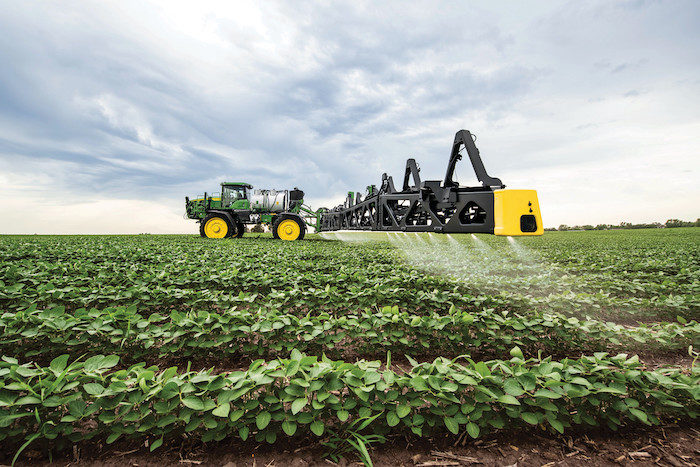John Deere will have “double-digit units” of its green-on-green See & Spray Ultimate targeted spraying system available to order later this year.
The company launched See & Spray Ultimate March 3. The factory-installed system allows farmers to spot spray non-residual herbicide on weeds among corn, soybeans and cotton. Blue River Technology, an artificial intelligence developer acquired by Deere in 2017, created the technology behind the green-on-green solution.
See & Spray Ultimate consists of cameras and processors mounted on a new carbon fiber truss-style boom to detect weeds among plants using artificial intelligence and machine learning. Thirty-six cameras are mounted on a 120-foot boom, meaning the system can scan more than 2,100 square feet at once.
“We’re excited to be the first full OEM to offer this type of solution,” says Franklin Peitz, marketing manager for John Deere.
Peitz says at 12mph, See & Spray Ultimate can reduce non-residual herbicide use by more than two-thirds, while maintaining a hit rate comparable to traditional spraying.
‘Double-Digit Units’ Available in U.S. Only
See & Spray Ultimate can be factory installed on model year 2023 John Deere 410R, 412R and 612R sprayers. Peitz says “double-digit units” will be made available for ordering later this year, which is also when pricing will be released.
The Des Moines Works sprayer factory in Ankeny, Iowa, will manufacture See & Spray Ultimate as the 410R, 412R and 612R sprayers are already produced in that factory. Peitz says See & Spray Ultimate is designed to be an easy transition for dealers who are currently selling and supporting Deere’s ExactApply individual nozzle control system.
“ExactApply is the foundation of See & Spray,” Peitz says. “There are new diagnostics and other things, but we’re working hand-in-hand with dealers this spring to get them trained and comfortable with supporting this type of technology.”
Deere will limit the first year production supply to dealers in the Midwest, Mississippi Delta and Texas, followed by a wider rollout in the coming years, according to Peitz. He says See & Spray Ultimate will likely only be available in the U.S. during the first couple years.
“This is really a speed-to-market product for us, so we’re just being agile and trying to learn a lot this season and next season to be able to make those decisions about when it makes sense to take it down to other markets,” Peitz says.
Dual Tanks Allow for Broadcast and Target Spraying
See & Spray Ultimate features a split tank with dual product capability. Tanks are available as 1,200 and 1,000 gallons. The 1,200-gallon option is split into a 450-gallon tank for targeted spraying and a 750-gallon tank for broadcast spraying. The 1,000-gallon option is split into a 350-gallon tank for targeted spraying and a 650-gallon tank broadcast spraying.
Peitz says most customers will likely broadcast a residual pre-emerge herbicide before or right after planting, while target spraying a non-residual herbicide to clean up the field. Farmers can also combine both tanks into one solution and only use target spray for a cleanup pass after emergence.
Deere conducted several strip trials comparing the dual-product solution to a broadcast, single-tank mix. In a trial in Illinois soybeans, the single-tank mix had 3 modes of action, while the dual tanks added a fourth mode that wouldn’t have been as effective in one tank due to antagonism. Peitz says See & Spray Ultimate’s dual-product pass resulted in 7% better weed control than the broadcast pass.
Some farmers are also testing out broadcasting an early season fungicide or insecticide while using target spraying to clean up remaining weeds, Peitz says. See & Spray Ultimate burndown passes are common among cotton producers.
New Boom Height Control System, RTK Signal
Additional features on See & Spray Ultimate include the new BoomTrac Ultimate boom height control system, JDLink connectivity, a new integrated StarFire 7000 GPS receiver and the Generation 4 CommandCenter display. The StarFire 7000 receiver brings to market a new type of RTK signal, SF-RTK, which relies solely on satellite communication.
After a pass is made, the system generates a map showing weed pressure in the John Deere Operations Center. Peitz says the map looks similar to a heat map with the areas sprayed for high weed pressure showing up in red and areas with low or no weeds shaded in green. The map doesn’t indicate what type of weeds were identified, but Peitz says Deere is actively working on advancing the system to identify and differentiate weeds.
See & Spray Ultimate Tested in Midwest, Mississippi Delta, Texas
The reveal of See & Spray Ultimate comes almost a year after Deere debuted See & Spray Select, a green-on-brown solution available on its 400 and 600 series sprayers. In June, Deere President of Production and Precision Ag Cory Reed announced that tests of See & Spray Ultimate pilot machines were in the works with limited production scheduled for 2022.
Peitz told Precision Farming Dealer that Deere had test cooperators in corn, soybeans and cotton in the Midwest, Mississippi Delta and Texas last season.
“This season, we have paying test cooperators in those same geographies in corn, soybeans and cotton in anticipation for ordering to take place later this year for the initial limited production of See & Spray Ultimate for the year 2023,” Peitz says. “Ag retailers will also have these units this year.”
Tests will be limited to corn, soybeans and cotton planted in 30-inch rows or greater, due to the current camera technology. An additional “double-digit” amount of dealers will have demo units out in the spring for demonstrations.
Deere plans to expand See & Spray Ultimate to other crops, according to Peitz, with Deere listening to customers and dealers about what crops are their priorities for using See & Spray Ultimate. Peitz says Deere is also looking into how to use the camera and vision technology to identify nutrient deficiencies and pests among crops.







Post a comment
Report Abusive Comment